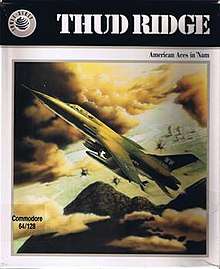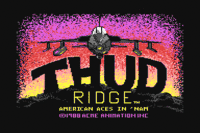Thud Ridge: American Aces In 'Nam
Thud Ridge: American Aces in 'Nam is a computer game published by Three-Sixty Pacific in 1988 for the Commodore 64 and MS-DOS.
 | |
| Developer(s) | Acme Animation |
|---|---|
| Publisher(s) | Three-Sixty Pacific |
| Designer(s) | Dave O'Mally Tris Orendorff Brian Hilchie |
| Artist(s) | Gordon Dean Griffiths Dan Hoecke |
| Composer(s) | Krisjan Hatlelid Krishna Bera |
| Platform(s) | Commodore 64, MS-DOS |
| Release |
|
| Genre(s) | Flight simulation |
| Mode(s) | single-player |
Plot
Thud Ridge is a combat flight simulator that allows the player to pilot a Republic F-105 Thunderchief—a "Thud"—during the Vietnam War. The player must contend with enemy MiGs, SAMs, flak, and a MiG ace known as the Grey Ghost. Thud Ridge presents 10 missions, with the degree of simulation difficulty decided by selecting either Lieutenant, Captain, or Colonel level. The player earns the Bronze Star by completing Missions 1 through 3, the Silver Star and a promotion to Colonel upon completion of Missions 4 through 6, and membership in the Wild Weasel Thud Drivers if the player accomplishes all ten missions.[1]

Gameplay
This game has few commands to learn in order to operate the aircraft. There is no digitized sound, just tinny beeps that indicate actions such as weapons firing. The player handles control of the aircraft by joystick, keyboard, or keypad. The player uses the joystick or keypad to direct the jet’s flight; the keyboard allows the player to input other control commands. The game possesses four basic screens, each offering different aspects of the jet's flight. One screen allows the player to view the aircraft functions screen. The main display presents a real-time view of the player's Thud and the geography of the area over which the plane is flying, as well as weapons and firing information. The plane has an automatic weapons cursor, the shape of which determines the weapon in use. The Engine Function Panel can appear below the real-time graphics display, and presents factors such as the engine and nozzle temperatures and fuel levels on gauges. Other data includes the plane's throttle, an afterburner indicator, the elapsed time of the mission, a radar-lock warning, and a graphic display of the Thud and the weapons remaining aboard. Also available is a screen that shows where SAM installations are located and a map screen.[1]
Reception
The game was reviewed in 1989 in Dragon #151 by Hartley, Patricia, and Kirk Lesser in "The Role of Computers" column. The reviewers gave the game 3 out of 5 stars.[1] A 1992 Computer Gaming World survey of wargames with modern settings gave the game two stars out of five.[2]
Reviews
- ASM (Aktueller Software Markt) - Nov, 1989
- Computer Gaming World - Jun, 1991
See also
References
- Lesser, Hartley; Lesser, Patricia; Lesser, Kirk (November 1989). "The Role of Computers". Dragon (151): 52–56.
- Brooks, M. Evan (June 1992). "The Modern Games: 1950 - 2000". Computer Gaming World. p. 120. Retrieved 24 November 2013.
External links
- Thud Ridge at MobyGames
- Thud Ridge at GameFAQs
- Thud Ridge at GameSpot